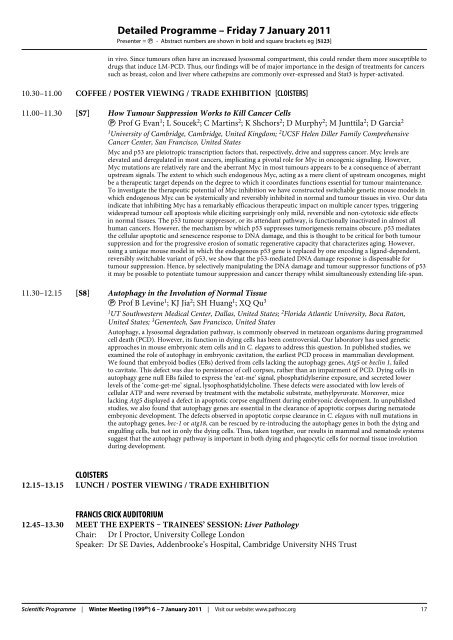Winter Meeting 2011 - The Pathological Society of Great Britain ...
Winter Meeting 2011 - The Pathological Society of Great Britain ...
Winter Meeting 2011 - The Pathological Society of Great Britain ...
Create successful ePaper yourself
Turn your PDF publications into a flip-book with our unique Google optimized e-Paper software.
Detailed Programme – Friday 7 January <strong>2011</strong><br />
Presenter = P · Abstract numbers are shown in bold and square brackets eg [S123]<br />
in vivo. Since tumours <strong>of</strong>ten have an increased lysosomal compartment, this could render them more susceptible to<br />
drugs that induce LM-PCD. Thus, our findings will be <strong>of</strong> major importance in the design <strong>of</strong> treatments for cancers<br />
such as breast, colon and liver where cathepsins are commonly over-expressed and Stat3 is hyper-activated.<br />
10.30–11.00 C<strong>of</strong>fee / Poster Viewing / Trade Exhibition [Cloisters]<br />
11.00–11.30 [S7] How Tumour Suppression Works to Kill Cancer Cells<br />
P Pr<strong>of</strong> G Evan 1 ; L Soucek 2 ; C Martins 2 ; K Shchors 2 ; D Murphy 2 ; M Junttila 2 ; D Garcia 2<br />
University <strong>of</strong> Cambridge, Cambridge, United Kingdom; 2 UCSF Helen Diller Family Comprehensive<br />
Cancer Center, San Francisco, United States<br />
Myc and p53 are pleiotropic transcription factors that, respectively, drive and suppress cancer. Myc levels are<br />
elevated and deregulated in most cancers, implicating a pivotal role for Myc in oncogenic signaling. However,<br />
Myc mutations are relatively rare and the aberrant Myc in most tumours appears to be a consequence <strong>of</strong> aberrant<br />
upstream signals. <strong>The</strong> extent to which such endogenous Myc, acting as a mere client <strong>of</strong> upstream oncogenes, might<br />
be a therapeutic target depends on the degree to which it coordinates functions essential for tumour maintenance.<br />
To investigate the therapeutic potential <strong>of</strong> Myc inhibition we have constructed switchable genetic mouse models in<br />
which endogenous Myc can be systemically and reversibly inhibited in normal and tumour tissues in vivo. Our data<br />
indicate that inhibiting Myc has a remarkably efficacious therapeutic impact on multiple cancer types, triggering<br />
widespread tumour cell apoptosis while eliciting surprisingly only mild, reversible and non-cytotoxic side effects<br />
in normal tissues. <strong>The</strong> p53 tumour suppressor, or its attendant pathway, is functionally inactivated in almost all<br />
human cancers. However, the mechanism by which p53 suppresses tumorigenesis remains obscure. p53 mediates<br />
the cellular apoptotic and senescence response to DNA damage, and this is thought to be critical for both tumour<br />
suppression and for the progressive erosion <strong>of</strong> somatic regenerative capacity that characterizes aging. However,<br />
using a unique mouse model in which the endogenous p53 gene is replaced by one encoding a ligand-dependent,<br />
reversibly switchable variant <strong>of</strong> p53, we show that the p53-mediated DNA damage response is dispensable for<br />
tumour suppression. Hence, by selectively manipulating the DNA damage and tumour suppressor functions <strong>of</strong> p53<br />
it may be possible to potentiate tumour suppression and cancer therapy whilst simultaneously extending life-span.<br />
11.30–12.15 [S8] Autophagy in the Involution <strong>of</strong> Normal Tissue<br />
P Pr<strong>of</strong> B Levine 1 ; KJ Jia 2 ; SH Huang 1 ; XQ Qu 3<br />
UT Southwestern Medical Center, Dallas, United States; 2 Florida Atlantic University, Boca Raton,<br />
United States; 3 Genentech, San Francisco, United States<br />
Autophagy, a lysosomal degradation pathway, is commonly observed in metazoan organisms during programmed<br />
cell death (PCD). However, its function in dying cells has been controversial. Our laboratory has used genetic<br />
approaches in mouse embryonic stem cells and in C. elegans to address this question. In published studies, we<br />
examined the role <strong>of</strong> autophagy in embryonic cavitation, the earliest PCD process in mammalian development.<br />
We found that embryoid bodies (EBs) derived from cells lacking the autophagy genes, Atg5 or beclin 1, failed<br />
to cavitate. This defect was due to persistence <strong>of</strong> cell corpses, rather than an impairment <strong>of</strong> PCD. Dying cells in<br />
autophagy gene null EBs failed to express the ‘eat-me’ signal, phosphatidylserine exposure, and secreted lower<br />
levels <strong>of</strong> the ‘come-get-me’ signal, lysophosphatidylcholine. <strong>The</strong>se defects were associated with low levels <strong>of</strong><br />
cellular ATP and were reversed by treatment with the metabolic substrate, methylpyruvate. Moreover, mice<br />
lacking Atg5 displayed a defect in apoptotic corpse engulfment during embryonic development. In unpublished<br />
studies, we also found that autophagy genes are essential in the clearance <strong>of</strong> apoptotic corpses during nematode<br />
embryonic development. <strong>The</strong> defects observed in apoptotic corpse clearance in C. elegans with null mutations in<br />
the autophagy genes, bec-1 or atg18, can be rescued by re-introducing the autophagy genes in both the dying and<br />
engulfing cells, but not in only the dying cells. Thus, taken together, our results in mammal and nematode systems<br />
suggest that the autophagy pathway is important in both dying and phagocytic cells for normal tissue involution<br />
during development.<br />
Cloisters<br />
12.15–13.15 Lunch / Poster viewing / Trade Exhibition<br />
Francis Crick Auditorium<br />
12.45–13.30 Meet the experts – Trainees’ Session: Liver Pathology<br />
Chair: Dr I Proctor, University College London<br />
Speaker: Dr SE Davies, Addenbrooke’s Hospital, Cambridge University NHS Trust<br />
Scientific Programme | <strong>Winter</strong> <strong>Meeting</strong> (199 th ) 6 – 7 January <strong>2011</strong> | Visit our website: www.pathsoc.org<br />
17













